Science
Reusing Recyclables: 10 Science Tools to Make for StudentsMay 22, 2024


Teaching about fall is a great way to start off the school year for your kindergarteners or 3rd graders that are studying weather patterns. Fall is unique in each region and will have its own set of weather patterns to be studied; by studying your local fall weather, your students are getting to use real-world application of knowledge as well as getting place-based learning opportunities. You’re also giving your students a chance to apply their science skills such as observing, science notebooking, writing and testing hypotheses, and analyzing data.
Included in this article are suggestions on how to introduce the fall season in a scientific way to your early childhood learners, information about fall weather and what it could look like, and how the change in seasons affects plants and animals.
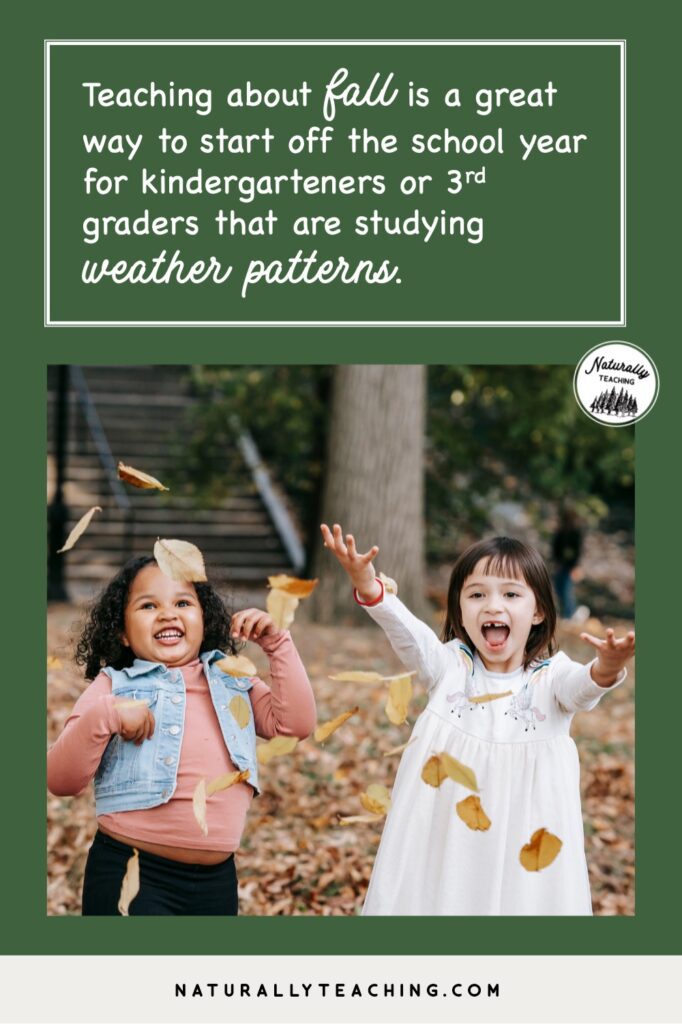
When teaching about fall, it is best to start with how the seasons are made (if you’re not sure how the seasons are made, check out this article “A Helpful Introduction for Teachers Teaching the Four Seasons in School”). This will give your students background information to draw upon for your fall unit. Since this is a very abstract concept, it’s best to introduce the concept to your students in a humorous way with 3D props.
To include some humor for your kindergarteners or 3rd graders, use a globe, a yard ball, or anything that is spherical to represent the Earth. Then choose someone with a bright yellow or orange hat or shirt to represent the sun. Show how the Earth is tilted and where you are on the planet. I am in the United States so I focus my students’ attention on the Northern Hemisphere. Have your student with the bright shirt stand or sit somewhere where all students can see them. Then show how the Earth orbits the sun while tilted by running around the “sun” student. The kids will think it’s hilarious, especially if you ham it up!
Stop running (and pretend like it was a lot of effort), and move to the point in the orbit where summer would be, also known as the Summer Solstice. For the Northern Hemisphere, this is when the top of the Earth is tilted toward the sun. And for the Southern Hemisphere, this is when the bottom of the Earth is titled toward the sun. This is the easiest position for children to see how the directness of sunlight is affected by the tilt.
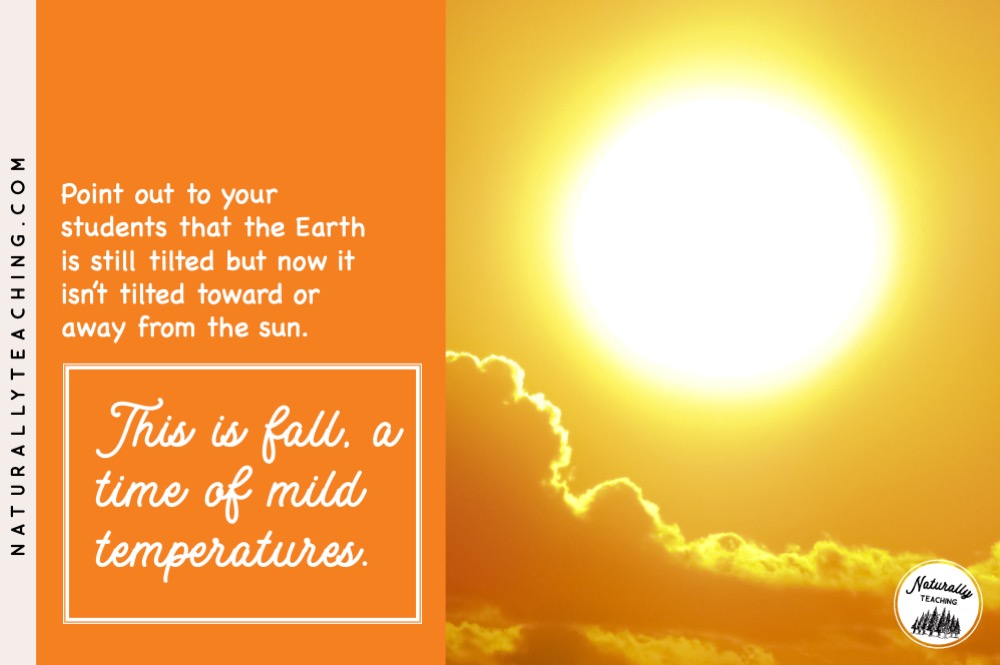
Point out to your students that the Earth is titled toward the sun in the summer position. This means that it gets the most direct sunlight, whereas the other part of the Earth gets less direct sunlight. There are also more hours of daylight in this position than night. Move to the fall position, the Autumnal Equinox, making sure you stay the same distance from your “sun”. Point out to your students that the Earth is still tilted but now it isn’t tilted toward or away from the sun. This is fall, a time of mild temperatures.
Teaching about fall is helpful to observe and identify weather patterns throughout the year in kindergarten and 3rd grade classrooms (NGSS K-ESS2-1 and 3-ESS2-1). After you teach your students the reason for fall, you can start to get into the weather of fall. Because there are neither direct or indirect sun rays on the part of the Earth experiencing fall, there are mild temperatures on average. This can include some really cold temperatures to really hot temperatures, depending on the day and the fronts that move in. Fall also brings with it wind from the changing pressure caused by the uneven heating of the Earth’s surface by the sun. Rain is also fairly common in fall.
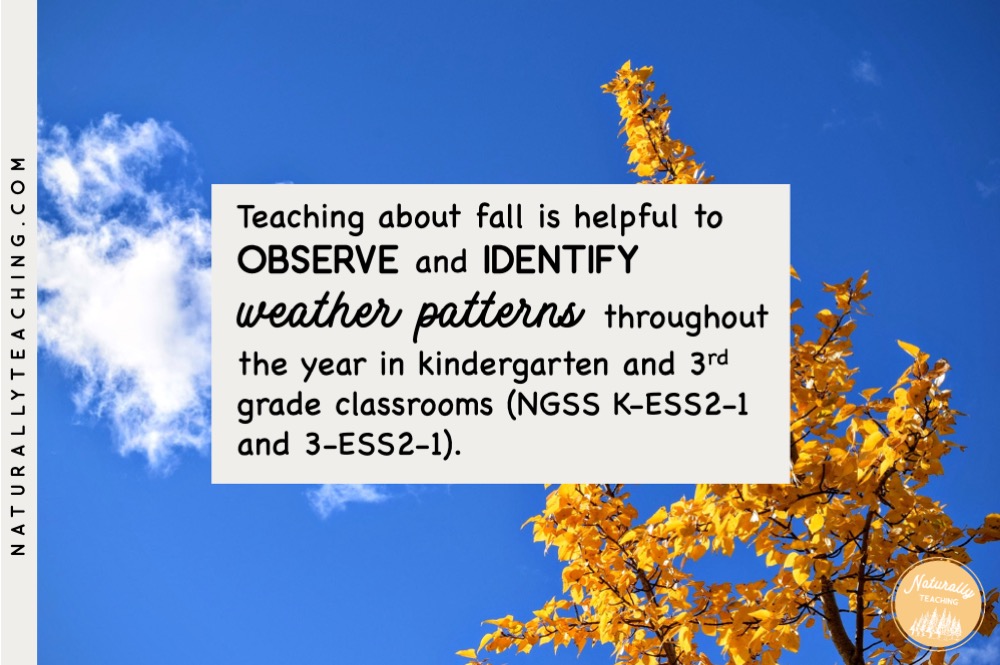
The transition from summer to fall is hard on your students as they move from hot temperatures to colder temperatures. One way to help your students remember what outdoor gear to bring for recess is by studying the weather each day at calendar or as part of their morning work. If you have jobs in your classroom, you could have a meteorologist who takes the weather data for the day. Another idea to study the weather each day would be to project a weather forecast onto the board as your students enter the classroom. This real-world data can also help them develop life skills that will play a part in their everyday lives as they get older. After they have talked weather, help them think through the types of clothes that they would need in order to be comfortable outside (this also helps you so you don’t have kiddos complaining about being cold during recess).
Teaching about fall can help your students understand why there is such a dramatic change in plants when the seasons shift. Related to the hours of daylight, plants recognize that they will not have enough sunlight to make their own food. Some plants, like perennials, will flower in the late summer and early fall and then die before winter. Their flowers get pollinated and the seeds will spread before spring, allowing the species to continue into the next year. Seeds spread in many different ways including falling from the plant, riding the wind, floating in water, hitchhiking on animal fur, propelling out of seed pods, being stored by animals and forgotten, and being eaten by animals and excreted out.
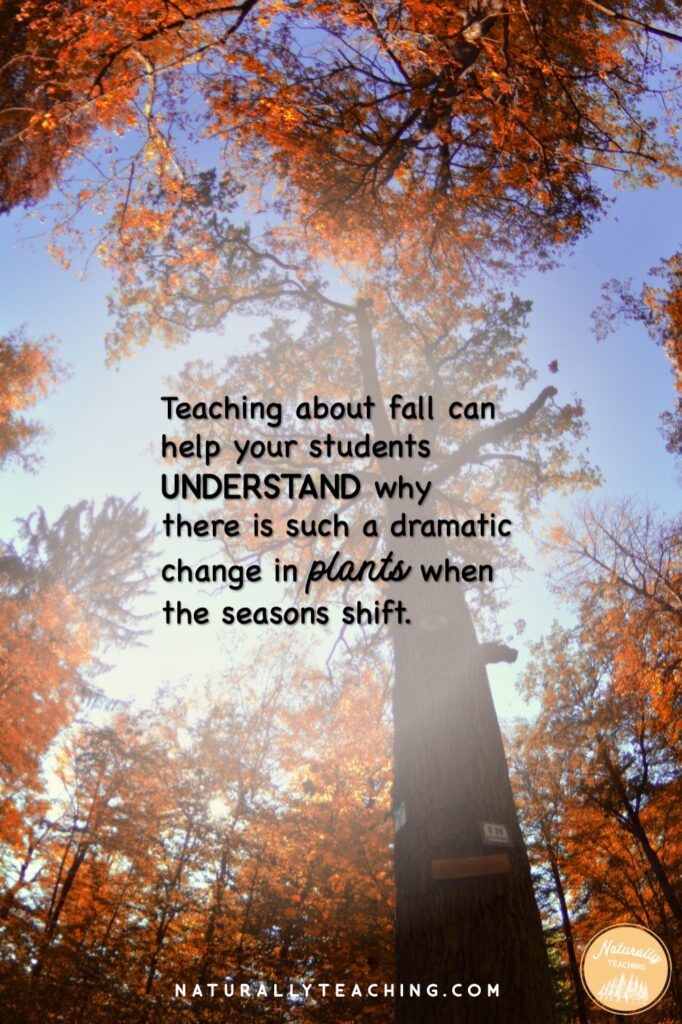
Some longer living plants, like trees and biennials, will go dormant, or rest for the winter. They stop their food production in the fall and shed their leaves. The colorful leaves of fall are something children, and adults, look forward to and is a very recognizable characteristic of the season. When they stop making food, trees move their leftover food to their roots where it is stored as a starch. This stored food will help open buds in the spring when the plant comes out of its rest. The buds are next year’s leaves and are already on the tree. Take your students outside and look closely at the ends of the twigs on trees to see if you can find next year’s leaves at the ready!
One overlooked, but important, benefit to trees shedding their leaves in the fall is the nutrient recycling that happens. When leaves land at the bottom of a tree they get decomposed by invertebrates, fungi, and other organisms. The decomposed matter will turn back into rich soil that the tree can use to grow in the years to come.
Teaching about fall can help your students understand what is happening to the animals around them when the seasons shift. Animals, like plants, are also in tune with the hours of daylight and are triggered to get ready for winter as the fall approaches.
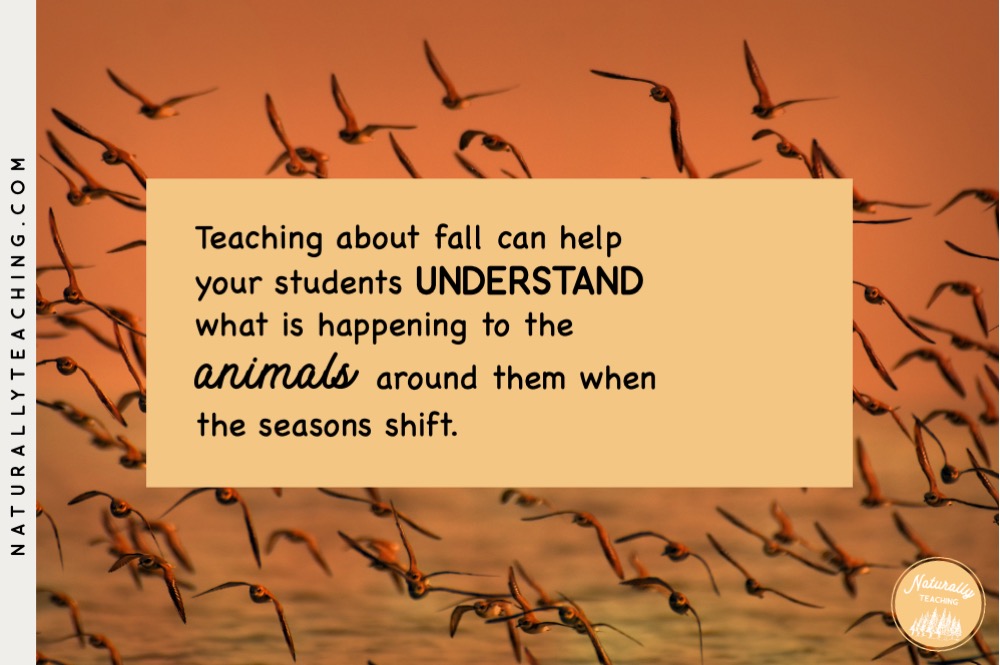
Some birds in fall migrate to areas that have their food source. Many articles and books will tell you that they are migrating because it is cold and they need a warmer place in the winter; that is not entirely true. During the winter, animals require more food to have energy to stay warm. Most birds could survive in their nesting range if they had the food they needed to make their own heat. If they live in a region where there isn’t enough food to generate the heat they need to survive, then they must go to a region that does. The types of birds that migrate tend to be those that rely on insects, flowers, fish, and aquatic plants for food. The types of birds that stay close to home tend to be those that rely on seeds, fruit, and meat for food. Teaching about fall and its affects on animals can help clear up this misconception with your students and maybe even your parents and colleagues.
Insects are cold-blooded and rely on nature to provide them heat, so they need to find creative ways to survive to the next year. Some butterflies, like the Monarch butterfly, will spend their fall migrating to warmer areas that have flowers. Other insects, like praying mantises, will propagate their species by laying eggs in the fall that will hatch in the spring. Some insects, like the Woolly Bear caterpillar (Isabella Tiger moth), will use fall to move to a place they can stay in their larval stage for the winter in a state of dormancy scientists refer to as diapause. Other insects, like the Cecropia moth, will morph from their larval stage to their pupa stage to overwinter as a cocoon on a tree branch. Still others, like honeybees will survive as adults, emerging from their tree cavity on warm days and huddling together on cold days.
Reptiles and amphibians are also cold-blooded and spend the fall getting ready for dormancy like so many others. Scientists refer to the dormancy of reptiles and amphibians as brumation, similar to hibernation. Frogs and turtles that live in ponds use the fall to burrow into the mud where they lower their heart rate, breathing rate, and other metabolic functions to conserve energy. Forest frogs, salamanders, lizards and turtles will do the same but will burrow into the soil below the frost line. The Wood frog, however, has a unique adaptation to survive winter; they are able to produce a chemical in their body similar to antifreeze which protects their cells from freezing. When people have found them they look like frogsicles, appearing to be frozen solid! Many snakes will find holes in the fall that extend below the frost line and sleep there for the winter. The Eastern Garter snake is a species that has been reported to gather in groups in holes, called hibernacula, where they will overwinter in a tangle of snakiness.
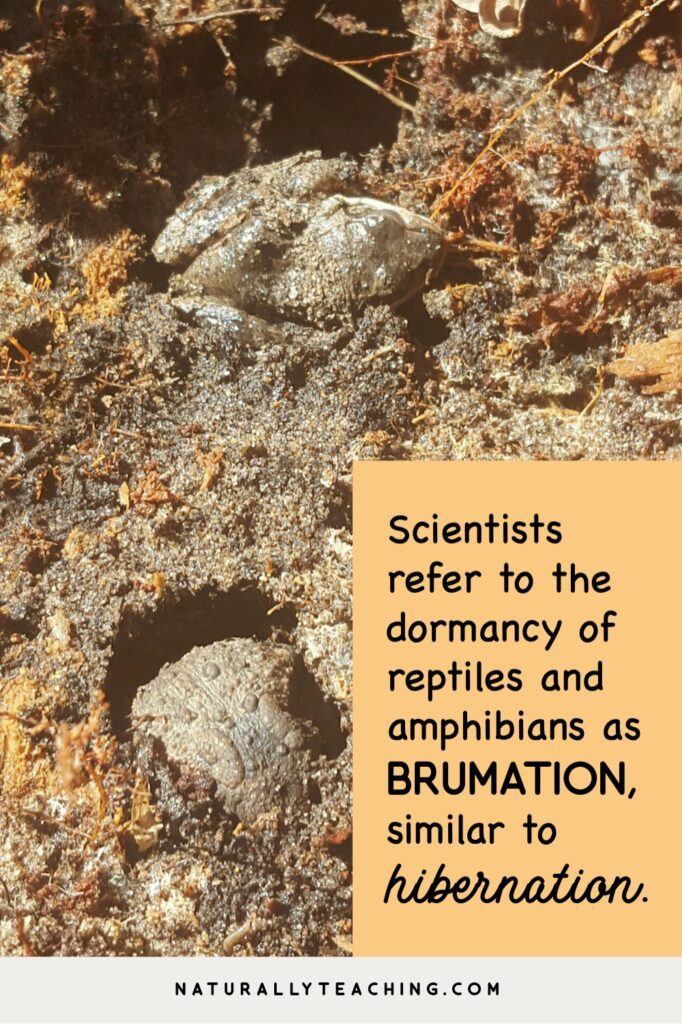
Fish are also cold-blooded and will start to slow down during the fall. Some fish, like salmon, will migrate to different areas during the fall season in order to reach their winter grounds. Most other fish will stay close to their homes, spending as little energy as possible during the colder months. Teaching about fall will help bring some of these unknown animal behaviors to light while also sparking your students’ curiosities.
Mammals are warm-blooded but use fall to get ready for winter as well. Some mammals, like squirrels, will spend fall caching, or hiding, food for the winter. Other mammals, like Woodchucks, spend fall eating as much food as possible and packing on the pounds to hibernate over winter. Some mammals, like the Hoary bat, migrate during the fall to other places that have the food they need to survive winter. There are also a lot of mammals that spend the winter active. Many of these mammals will shed their fur during fall and grow thicker coats. Some of them even experience a color change when they shed their fur in fall, like the Snowshoe hare.
Teaching about fall holds so much value for your students while helping you fulfill your curricular goals. By teaching about fall, your students get to study the weather patterns of the season, practice their scientific skills, and see how nature is interconnected with real-life applications of new knowledge during place-based learning opportunities. Enjoy this wonderful season with its mild weather, beautiful colors, and enjoyable holidays; it is sure to be one of your students’ favorite times of the year!
Looking for activities to help you teach the fall season? Check out our fall seasonal resources with activities like a summer to fall sorting worksheet, a seasonal booklet, and an outdoor scavenger hunt!
Bibliography
Lawrence, B. 2021, September 21. Explaining how Midwest wind develops. We Are Iowa. Retrieved from https://www.weareiowa.com/article/weather/weather-lab/heres-why-its-often-so-windy-in-fall-winter-and-spring-des-moines-central-iowa/524-fbb13fbc-2734-4486-a97a-60a13967fc24
Do you have an amazing way that you spend your time teaching about fall? Include your favorite activities in the comments!
Looking for other articles about the seasons to help you teach weather all school year long? Check these out!
“A Helpful Introduction for Teachers Teaching the Four Seasons in School”
“A Helpful Guide to Teaching the Season Transition to Winter”
“A Helpful Guide to Answering the Question ‘What is the Spring Season?'”
4 thoughts on “A Helpful Guide to Teaching About Fall in Elementary School”